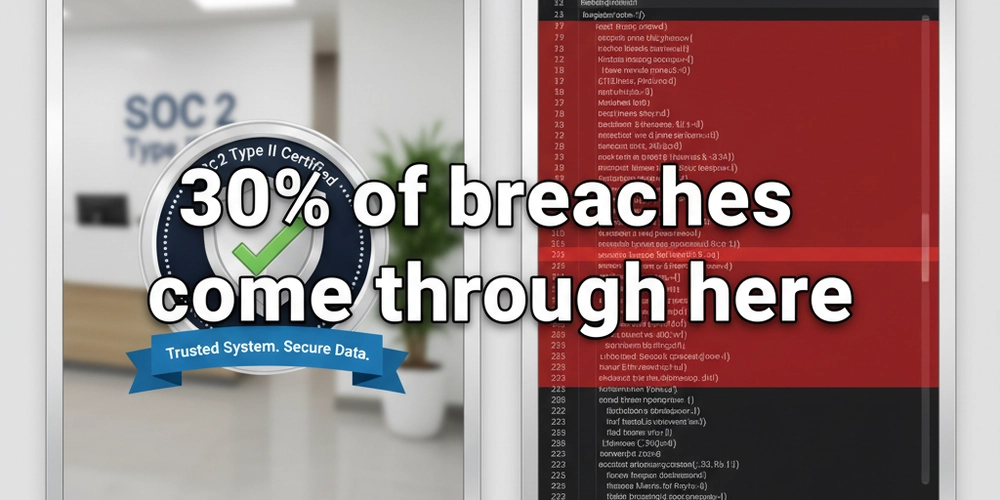Hey DevTO fam!
Let’s talk about something that’s been bugging me for weeks. I keep seeing companies celebrating their SOC 2 compliance like they just won the Champions League, but then getting absolutely destroyed by supply chain attacks.
It’s like locking your front door but leaving all your windows wide open.
The Numbers That Made Me Do a Double Take
I was researching for a client project when I stumbled across some data that made me spit out my morning coffee:
Verizon’s 2025 Data Breach Report:
- 30% of all breaches now involve third-parties (that’s doubled in one year!)
IBM’s Cost of Data Breach Report 2025:
- Average breach cost: $4.44 million globally, $10.22 million in the US
- Supply chain breaches take 267 days to detect and fix
- 75% of organizations got hit by supply chain attacks last year
So while we’re all busy checking SOC 2 boxes, attackers are basically walking through the back door via our vendors.
Real Talk: Case Studies That’ll Keep You Up at Night
SolarWinds (2020) – The “Trust No One” Moment
Russian hackers compromised SolarWinds’ build environment and pushed malware to 18,000 customers. Companies with pristine SOC 2 reports got pwned because they trusted their vendor’s software updates.
Lesson: Your vendor’s SOC 2 certificate won’t help when their build pipeline gets compromised.
3CX (2023) – The Domino Effect
This one’s wild. Attackers compromised Trading Technologies’ software → 3CX employee downloaded it → attackers pivoted to 3CX’s build servers → pushed malware to all 3CX customers.
It’s like that game where one person falls and takes everyone down.
Source: CrowdStrike’s detailed analysis
XZ Utils (2024) – The Patient Game
Someone spent 2+ years building trust in the open source community, became maintainer of a compression library, then tried to backdoor millions of Linux servers. Only got caught by accident.
The scary part: This almost worked perfectly.
Source: Ars Technica’s breakdown
The Three Blind Spots Your SOC 2 Audit Creates
1. Vendor Security Theater
Your SOC 2 auditor asks: “Do you assess vendor risks?”
You show them your folder of vendor SOC 2 reports from last year.
✅ Box checked. Audit passed.
Reality check: Those reports are static snapshots. Meanwhile, ReversingLabs found 704,102+ malicious packages in open source repos since 2019, with a 1,300% increase from 2020-2023.
Your “trusted” dependencies might be compromised right now.
2. The SBOM Gap
Quick question: Can you list every third-party component in your production apps?
If you hesitated, you’re not alone. Most companies have no idea what’s actually running in their systems.
Why this matters: When Log4j dropped, companies with Software Bills of Materials (SBOMs) knew their exposure in minutes. Everyone else spent weeks figuring out if they were affected.
3. Build Pipeline Assumptions
Your development environment is locked down tight. Your CI/CD pipeline? Also secure.
But what about the packages you’re pulling from npm, PyPI, or Maven Central during builds?
Both SolarWinds and 3CX got compromised through their build processes, not their development laptops.
What Actually Works (From Someone Learning This Stuff)
Full disclosure: I’m new to offering security assessments. This article is partly me learning in public and partly sharing what I’ve discovered.
Here’s what I think actually helps:
Software Bill of Materials (SBOM)
Generate inventories of all your software components. Standards like SPDX and CycloneDX make this machine-readable.
Why: Know what you’re running so you can respond fast when vulnerabilities drop.
Dependency Scanning
Tools like Snyk, OWASP Dependency-Check, or GitHub’s security features can catch known vulnerabilities in your dependencies.
Integration: Add this to your CI/CD pipeline so you catch problems before they hit production.
Vendor Monitoring Beyond SOC 2
Instead of just collecting annual reports, monitor your vendors’ security posture continuously.
Reality: Most companies learn about vendor breaches from Twitter, not their monitoring systems.
My Experiment: Supply Chain Security Assessment
I’m putting together a supply chain security assessment service. Since I’m new to this space, I’m starting with realistic pricing:
What I’m offering:
- Analysis of your current SOC 2 coverage gaps
- Software dependency vulnerability assessment
- Vendor risk evaluation beyond compliance reports
- Practical recommendations you can actually implement
Pricing: $300-800 (I’m testing the waters here)
Timeline: 3-5 days
Honesty: This is my first venture into security assessments, so we’re learning together
The Self-Assessment Checklist
Quick reality check:
- Can you generate an SBOM for your main applications?
- Do you scan dependencies for vulnerabilities automatically?
- Would you know within 24 hours if a critical vendor got breached?
- Can you verify the integrity of packages you download during builds?
If you answered “no” to any of these, your SOC 2 compliance isn’t covering your actual risk.
What’s Next?
I’m genuinely curious about your experiences. Have you dealt with supply chain security issues? What’s worked? What hasn’t?
Drop your thoughts in the comments. Let’s figure this out together.
Resources that helped me understand this:
Tags: #cybersecurity #supplychainsecurity #soc2 #devops #learninginpublic #softwaresecurity



